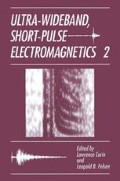Abstract
The finite-difference time-domain (FDTD) method has been used to analyze a number of antennas for pulse radiation. In complexity, these antennas range from simple metallic monopoles to more complicated resistively loaded structures such as the bow-tie and TEM horn [1]–[10]. Almost all of these analyses have been for antennas in the transmitting mode, where the internal reflections and pulse distortion on radiation were of concern, see Figure 1(a). There has been very little discussion of these antennas in the receiving mode, see Figure 1(b).
Access this chapter
Tax calculation will be finalised at checkout
Purchases are for personal use only
Preview
Unable to display preview. Download preview PDF.
References
J. G. Maloney, G. S. Smith and W. R. Scott Jr., Accurate computation of the radiation from simple antennas using the finite-difference time-domain method, IEEE Trans. Antennas Propagat., 38:1059 (1990)
J. G. Maloney and G. S. Smith, A study of the transient radiation from the Wu-King resistive monopole-FDTD analysis and experimental measurements, IEEE Trans. Antennas Propagat., 41:668 (1993).
J. G. Maloney and G. S. Smith, Optimization of pulse radiation from a simple antenna using resistive loading, Microwave and Optical Technology Letters, 5:299 (1992).
J. G. Maloney and G. S. Smith, Optimization of a conical antenna for pulse radiation: an efficient design using resistive loading, IEEE Trans. Antennas Propagat., 41:940 (1993).
J. G. Maloney, “Analysis and synthesis of transient antennas using the finite-difference time-domain (FDTD) method,” Ph.D. Dissertation, Georgia Institute of Technology, Atlanta, GA, 1992.
J. G. Maloney and G. S. Smith, The efficient modeling of thin material sheets in the finite-difference time-domain (FDTD) method, IEEE Trans. Antennas Propagat., 40:323 (1992).
K. L. Shlager, G. S. Smith, and J. G. Maloney, Optimization of bow-tie antennas for pulse radiation, IEEE Trans. Antennas Propagat., to appear, July 1994
K. L. Shlager, G. S. Smith, and J. G. Maloney, Accurate analysis of metallic TEM horn antennas for pulse radiation using the FDTD method, Proc. 1994 IEEE AP-S Int. Symp, Seattle, Washington, 3:1786 (1994).
J. G. Maloney, B. L. Shirley, and G. S. Smith, Physical description for the reception of short pulses by antennas, Proc. 1994 IEEE AP-S Int. Symp, Seattle, Washington, 3:1790 (1994).
J. G. Maloney and G. S. Smith, Accurate modeling of antennas for radiating short pulses, FDTD analysis and experimental measurements, “Ultra-wideband short-pulse electromagnetics”, edited by H. L. Bertoni, et. al., Plenum Press, New York, 149 (1993).
K. S. Yee, Numerical solution of initial boundary value problems involving Maxwell’s equations in isotropic media, IEEE Trans. Antennas Propagat., AP-14:302 (1966).
Z. P. Liao, H. L. Wong, B. P. Yang, and Y F. Yuan, A transmitting boundary for transient wave analysis, Scientia Sinica (series A) 1063 (1984).
K. S. Yee, D. Ingham, and K. Shlager, Time-domain extrapolation to the far field based on FDTD calculations, IEEE Trans. Antennas Propagat., 39:410 (1991).
J. G. Maloney, K. L. Shlager, and G. S. Smith, A simple FDTD model for transient excitation of antennas by transmission lines, IEEE Trans. Antennas Propagat., 42:289 (1994).
J. A. Landt, and E. K. Miller, Transient response of the infinite cylindrical antenna and scatterer, IEEE Trans. Antennas Propagat., 24:246 (1976).
Author information
Authors and Affiliations
Editor information
Editors and Affiliations
Rights and permissions
Copyright information
© 1995 Springer Science+Business Media New York
About this chapter
Cite this chapter
Maloney, J.G., Shirley, B.L., Smith, G.S. (1995). The Reception of Short Pulses by Antennas: FDTD Results and Reciprocity. In: Carin, L., Felsen, L.B. (eds) Ultra-Wideband, Short-Pulse Electromagnetics 2. Springer, Boston, MA. https://doi.org/10.1007/978-1-4899-1394-4_21
Download citation
DOI: https://doi.org/10.1007/978-1-4899-1394-4_21
Publisher Name: Springer, Boston, MA
Print ISBN: 978-1-4899-1396-8
Online ISBN: 978-1-4899-1394-4
eBook Packages: Springer Book Archive

